Summer 2022
Message from the Chair
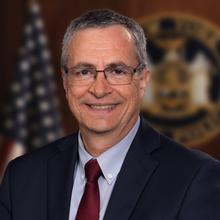
Greetings! It has been my pleasure to serve as the Forensic Science Standards Board (FSSB) Chair for 2021-22 and to provide a message on behalf of our Board. First, please accept my thanks and appreciation to our membership who unselfishly donate their time, enthusiasm and expertise to our noble mission, the generation of draft documents for standards developing organizations (SDO)s, which in turn will lead to technically sound standards that populate the OSAC Registry. The COVID-19 pandemic has presented tremendous challenges in many aspects of our lives and working to advance standards development was no exception. While the pandemic has promoted the honing of our remote meeting skills, it was wonderful to have the opportunity to again meet with colleagues in person during our OSAC Meetings this past May and June.
The summer edition of the OSAC newsletter is focused on the Registry and standards implementation. We take great pride in the diversity of viewpoints and stakeholders that we engage as part of the standards development process. Combining our diversity into consensus documents can be an arduous process, however it produces more refined and resilient end products that are worth the effort. These efforts are bearing fruit in terms of the number and quality of standards on the OSAC Registry. I would like to take a moment to congratulate OSAC members, affiliates, and stakeholders upon reaching the milestone of adding the 100th standard to the OSAC Registry! This is a landmark achievement that is the direct result of your hard work and dedication! Thank you!
As we broaden our focus to standards implementation, we recognize the tremendous pool of knowledgeable experts in the forensic science community that graciously give their time and talents in creating documents that become standards on the OSAC Registry. Our mission of improving forensic science, however, falls short if these standards are not implemented by forensic science service providers (FSSPs). Given that many of you who have been closely involved in the process have already implemented many of the standards on the OSAC Registry, we are reaching out for your capability in mentoring other FSSPs to assist in their implementation process. To that end, many of you are doing just that – providing presentations, workshops, and assistance – to support your colleagues as they begin to implement the standards on the OSAC Registry. We applaud this initiative and wish to build on this capability in assisting all FSSPs in achieving implementation. Development of tools to assist implementation are in process, however we wish to better leverage our existing pool of talent to help others attain standards implementation.
A final thought I would like to leave with you is to recognize that our job is continuous improvement; it is never done. FSSPs do not want for lack of job security. Creating the standards that populate the OSAC Registry is just the beginning, with reviews and updated versions occurring every five years. We have made tremendous progress, however our current version of documents are a foundation for future versions to be built upon. Thank you again for your selfless dedication to the betterment of forensic science as a lifelong endeavor.
Respectfully,
Ray Wickenheiser, FSSB Chair
OSAC News
The summer edition of the OSAC newsletter is all about the Registry and standards implementation. Read about OSAC’s latest Registry milestone and our progression from facilitating the development of standards to putting implementation into action in this special newsletter issue!
OSAC Registry: A Centennial Celebration!
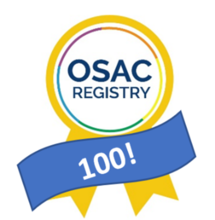
OSAC has reached a new milestone this summer – we’ve added the 100th standard to the Registry! As of August 2, 2022, the OSAC Registry contains 101 forensic science standards representing 20 disciplines.
Administered by the National Institute of Standards and Technology (NIST), OSAC was created in 2014 to address a lack of discipline-specific forensic science standards. OSAC fills this gap by drafting proposed standards and sending them to standards developing organizations (SDOs), which further develop and publish them. OSAC also reviews standards and posts high quality ones to the OSAC Registry. Inclusion on the OSAC Registry indicates that a standard is technically sound and forensic science service providers (FSSPs) should consider implementing it.
At OSAC’s inception, no discipline-specific forensic science standards existed on the Registry. OSAC added the first standard, ASTM E2329-14, Standard Practice for the Identification of Seized Drugs, to the Registry in January 2016. By the end of that fiscal year (September 30, 2016), NFPA 921:2014, Guide for Fire and Explosion Investigation and ISO/IEC 17025:2005 General Requirements for the Competence of Testing and Calibration Laboratories had been posted. During the next three years, OSAC evaluated and approved 22 more standards, adding the 25th standard to Registry in December 2019 (FY 2020).
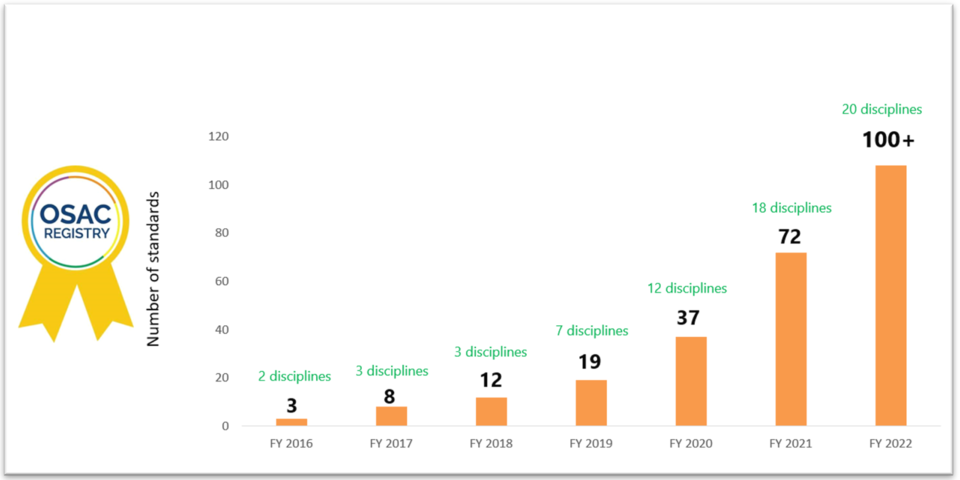
Standards development can be a long and sometimes contentious process. It involves bringing together various stakeholders with different backgrounds, experiences, and perspectives to reach consensus on a given topic. To help get standards out to the forensic science community more quickly, in October 2020, NIST launched a new and streamlined OSAC. Changes to OSAC’s structure and processes included expanding the number of Scientific Area Committees (SACs) from five to seven, reducing the number of subcommittees from 25 to 22, and absorbing the resource committees into the subcommittees and task groups. Also, as part of the new and improved OSAC, technical review and public commenting on standards were incorporated earlier in the drafting process to reduce the number of revisions and the time needed for proposed standards to be developed and published. Finally, to give forensic science service providers a jump on using standards, both SDO-published and OSAC proposed standards were included on the Registry.
For standards on the OSAC Registry to have an impact, they must be used. In the United States, there is no regulatory authority that sets mandatory standards or requirements that FSSPs must follow. OSAC, therefore, relies on the desire of the forensic community to self-adopt standards and best practices. Fortunately, the forensic community strongly supports standards development, and currently over 90 FSSPs have voluntarily implemented standards on the OSAC Registry to improve their processes and demonstrate their commitment to quality and accuracy. In addition to FSSPs, seven professional organizations have also formally published policy statements declaring their support for forensic science standards development and implementation.
As more published and OSAC-proposed standards are added to the OSAC Registry, OSAC wants to better understand how standards are being used, the challenges encountered in their implementation, and what support is needed. In addition to self-declaration by FSSPs, the OSAC Registry Implementation Survey is another tool OSAC uses to collect implementation information on an annual basis. The first OSAC Registry Implementation Survey was conducted in June 2021 when 46 standards were on the Registry. That survey indicated that 138 FSSPs had fully or partially implemented some of the standards on the OSAC Registry. OSAC’s second Registry Implementation Survey, conducted between June and August 2022, will assess FSSP implementation of 95 standards on the OSAC Registry. The preliminary results from this survey will be shared in OSAC’s Fall Newsletter/Annual Report, and a detailed report will be available in early 2023.
Although the number of FSSPs using standards on the OSAC Registry is increasing, challenges to implementation still exist. Targeted training, outreach and tools are critical for the full benefit of these activities to be realized. To help with implementation efforts, in late 2021, NIST entered into a cooperative agreement with the American Academy of Forensic Sciences (AAFS) to develop resources and training to help FSSPs with their implementation efforts.
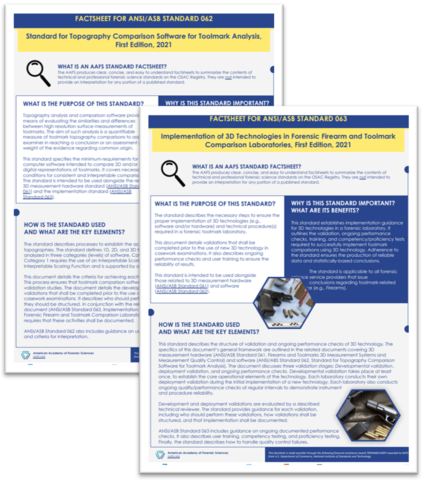
One of these resources, AAFS Standards Factsheets, provide a clear, concise, and easy way to understand the purpose of a standard, why it is needed, and the benefits of adoption. AAFS Factsheets are currently available for 22 standards listed on the OSAC Registry. For example, factsheets have been developed for the two latest Registry additions, ANSI/ASB Standard 062, Standard for Topography Comparison Software for Toolmark Analysis, First Edition 2021 and ANSI/ASB Standard 063, Implementation of 3D Technologies in Forensic Firearm and Toolmark Comparison Laboratories, First Edition, 2021. Both standards were drafted by OSAC’s Firearms & Toolmarks Subcommittee and provide guidance on purchasing, setting up and implementing 3D systems. The AAFS Standards Factsheets are continuously being produced and more are on the way.
Another resource, Standards Checklists, are tools FSSPs can use to track progress towards implementation, identify gaps or barriers to implementation, or document objective evidence of implementation or compliance of a standard. Checklists for six standards are being finalized now and it’s anticipated that 30 checklists will be available by the end of September 2022. FSSPs will have an opportunity to learn more about how to use these checklists at the 2022 Association of Forensic Quality Assurance Managers (AFQAM) Training Conference in October and 2023 AAFS Annual Scientific Conference in February.
Standards development and implementation is a continuous process. OSAC is proud to have reached this latest Registry milestone and looks forwards to future engagement and collaboration with relevant stakeholder groups such as FSSPs, SDOs, proficiency test providers, accrediting bodies, certification bodies, and forensic science professional organizations to learn more about their specific needs and support their standards implementation efforts.
Registry Implementation in Action
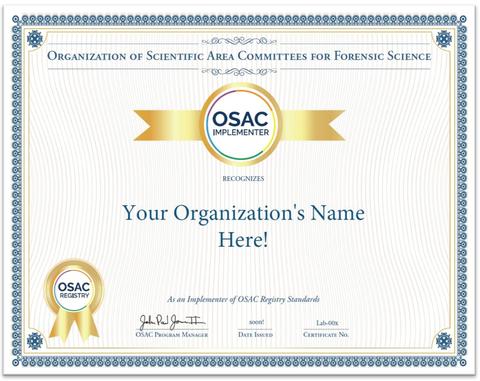
In addition to the OSAC Registry Implementation Survey, FSSPs can let OSAC know about their implementation efforts by completing OSAC’s Registry Implementation Declaration Form. As of August 2022, OSAC has received 91 self-declaration forms from 22 states:
- 57 state lab locations (11 states)
- 22 local/country/city labs
- 4 Federal labs
- 4 private labs
- 2 university labs
- 2 international labs
Check out the media releases from some of these OSAC Registry Implementers highlighting and celebrating their effort!
Is your organization putting standards implementation into action? Complete the Registry Implementation Declaration Form on the OSAC website to let us know, and you will receive a certificate in recognition of your efforts.
Implementation Insight: Defining Full and Partial Implementation of Standards
Courtesy of Mark Stolorow, OSAC Program Office
What is the difference between full implementation and partial implementation of a standard? Many FSSPs have shared their experiences with the OSAC Program Office about the challenge of defining partial implementation. Does the laboratory satisfy sufficient criteria to report that it has achieved partial implementation of a standard or should they report it as not yet implemented?
The purpose of this article is to share the experiences of six forensic science laboratories in addressing the challenge of defining partial implementation and the recommendations they provided to help other FSSPs mitigate this challenge.
OSAC was designed to specifically give voice to grass roots forensic science practitioners in the development and implementation of standards. Throughout the history of OSAC, its membership has been composed of more than 50% practitioners. The reason behind this operational strategy is that OSAC can only succeed if the forensic science community supports the standards that have been developed and are on the OSAC Registry. The best way to do this is to empower practitioners in the standards development and implementation processes.
For this reason, OSAC has consistently encouraged forensic science service providers to own their quality system from the bench up. Having a framework of participative management, where the bench scientists through their section technical leaders are represented to senior management and the QA manager, is the surest path to commitment to standards implementation in any organization. With over 100 standards now on the OSAC Registry and more than 90 laboratories having submitted to OSAC their standards implementation declaration forms, there is evidence-based data to demonstrate that the strategy of participative management is bearing fruit in achieving the OSAC mission.
Rather than creating one single OSAC definition of full and partial implementation and forcing that definition to be applicable and effective for all FSSPs from the top down, we instead elected to ask six laboratories to provide and share examples of their own definitions. We encourage each agency to discuss and develop their own definitions internally and apply them consistently across all disciplines within their organizations.
1. From Tate Yeatman, Crime Laboratory Director, Palm Beach County Sheriff’s Office:
The following definitions have been created to help you fill out the form and determine if you are fully or partially implementing a standard.
- Fully Implemented: All requirements within an OSAC registry standard have been implemented where applicable.
- Partially Implemented: Not all requirements within an OSAC registry standard have been implemented where applicable.
- Applicable standards: Standards that can be applied. Note: A standard is not applicable only if we currently do not perform the laboratory activity or have the instrumentation referred to within the standard.
2. From Eva M.L. King, Assurance Director, Wisconsin State Crime Laboratories:
We wanted the definitions to have flexibility and Unit (Leader) authority. Here they are:
- Full implementation – Complete compliance of OSAC standard upon declaration or update by the Unit.
- Partial implementation – Compliance with a portion of an OSAC standard as defined by the declaring Unit.
3. From Reta Newman, Director, Pinellas County Forensic Laboratory:
- Full implementation – all REQUIRED (shall) criteria are met, and the majority of RECOMMENDED (should) criteria have been met.
- Partial implementation – some, but not all, of the REQUIRED (shall) are met or majority of RECOMMENDED (should) have not been met AND it is our intent to work toward full compliance (through additional validation, policy revisions, training, etc.).
4. From Peter Stout, CEO, and Erika Ziemak, Quality Manager, Houston Forensic Science Center:
Here are two excerpts from the HFSC Quality Manual effective March 15, 2022:
- [Full Implementation:] HFSC staff will follow the requirements set forth in this manual as well as those in the current version of ISO/IEC 17025 General Requirements for the Competence of Testing and Calibration Laboratories, any applicable supplemental requirements, and the current FBI Quality Assurance Standards for Forensic DNA Testing Laboratories. Applicable sections are accredited by and follow the requirements of the Texas Forensic Science Commission (TFSC). HFSC will also meet applicable standards published on the Organization of Scientific Area Committees (OSAC) for Forensic Science Registry. If TFSC requirements conflict with OSAC Registry standards, HFSC will follow the TFSC requirements.
- [Partial Implementation:] Discipline-specific manuals will not be less stringent than this Quality Manual. OSAC Registry includes standards applicable to individual forensic science disciplines as well as cross-disciplinary use. When applicable standards are published on the OSAC Registry, these will be implemented within a year of being published. Once an OSAC Registry standard has been implemented, conformance and clauses that cannot be followed in their totality will be documented in the HFSC OSAC Registry Compliance Form located in Qualtrax.
A slightly different approach was adopted by the Kentucky State Police Forensic Science Laboratories and the Texas Department of Public Safety Crime Laboratory Division. Their quality system operates without using specific definitions of full or partial implementation but rather uses the following language in their Quality Manuals.
5. From Jeremy Triplett, Laboratory Director, Kentucky State Police Central Forensic Science Laboratory:
Seized Drugs Quality Manual (current revision effective 7/27/20):
7.2.1 Selection and verification of methods
7.2.1.1 The Kentucky State Police Seized Drugs section adheres to standards and guidelines from the Organization of Scientific Area Committees for Forensic Science (OSAC) and recommendations by the Scientific Working Group for the Analysis of Seized Drugs (SWGDRUG) in formulating its testing methods and procedures. During the annual review of seized drugs documents, OSAC and SWGDRUG standards, guidelines, and recommendations that have been published within the prior year will be evaluated for incorporation into the laboratory’s policies and procedures.
7.7 Ensuring the validity of results
7.7.1 The seized drugs section ensures the validity of results with quality control schemes including but not limited to:
- Adherence to Organization of Scientific Area Committees (OSAC) standards and guidelines
6. From Melissa Valadez, Assistant Laboratory Director – Technical Services, Texas Department of Public Safety Crime Laboratory Division:
We don’t define full or partial implementation in our policies for Texas DPS.
We did update our primary manual earlier this year to discuss the general implementation of OSAC standards. The revision was in our Quality Policy Statement:
- C. The Laboratory is committed to providing an impartial, defect-free service to all customers through:
- 8. Implementation of applicable published standards on the Organization of Scientific Area Committees (OSAC) for Forensic Science Registry.
Generally, we don’t consider a standard to be fully implemented until we can point to a policy that demonstrates compliance. Some of the standards that we are marking as partially implemented are just waiting for SOP updates. In practice, they are fully implemented, but the requirements from the standards are not described or outlined in policy yet.
OSAC recognizes that practitioner buy-in and support is needed for standards implementation to be successful. Some FSSPs will define partial and full implementation for themselves, commit those definitions to writing, and ensure that all the technical leaders apply those definitions consistently across the board. Alternatively, some FSSPs might elect not to define full and partial implementation at all, but rather choose to word their quality manuals to specify compliance consistently across disciplines without using those terms.
We hope this article provided an opportunity to see how other FSSPs have defined these terms and will be helpful to the forensic science community.
OSAC in the News
An Update from the Organization of Scientific Area Committees for Forensic Science
The August 2022 issue of the ISHI Report shared updates about the tools, training and resources being developed through the NIST and AAFS cooperative agreement to assist with standards implementation efforts.
Two New Forensic Firearm Examination Standards Added to the OSAC Registry of Approved Standards
This NIST news article highlighted two forensic firearm examination standards, the 100th and 101st standards to be placed on the OSAC Registry. This article was reshared by Homeland Security Today and WTOP News published a follow-up article, How 3D Images Could Help Solve Future Gun Crimes.
How Updating Forensic Science Standards Will Improve the Criminal Justice System
Read more about OSAC and the Registry in this A&E True Crime Blog.
OSAC’s Human Forensic Biology Subcommittee Develops DNA Analysis Process Map
Forensic Magazine reshared this OSAC news update highlighting the DNA Process Map.
Advancing the Practice of Forensic Science in the United States – Practitioners’ Efforts
Read about the efforts that have been made, including the development of standards, to improve forensic science in this Forensic Science Review article update.
Planning, design and logistics of a decision analysis study: The FBI/Ames study involving forensic firearms examiners
OSAC is referenced several times in this Forensic Science International: Synergy paper that describes the design and logistical aspects of a decision analysis study to assess the performance of firearms examiners.
OSAC & Other Forensic Science Events
Sept 11-16: Midwestern Association of Forensic Scientists (MAFS)/American Society of Trace Evidence Examiners (ASTEE) Annual Meeting
Sept 13: OSAC Public Update Meeting
Sept 18-24: National Forensic Science Week
Sept 20-22: OSAC Leadership Strategy Session and quarterly FSSB meeting
Oct 11-14: Association of Forensic Quality Assurance Managers (AFQAM) Training Conference
Oct 21: WEBINAR: ANSI/ASB Standard 036, Standard Practices for Method Validation in Forensic Toxicology
Oct 27: WEBINAR: Bitemark Analysis – A NIST Scientific Foundation Review
Oct 31-Nov 3: International Symposium on Human Identification (ISHI)
Nov 8-15: Forensics@NIST 2022
NIST Research Activities
Two New Forensic Firearm Examination Standards Added to the OSAC Registry of Approved Standards
Forensic firearms examiners have been linking bullets to guns for more than 100 years by visually inspecting the bullets under a microscope. Now, two new standards – posted on the OSAC Registry – can guide crime labs in setting up new systems that produce more detailed ballistic comparisons.
NIST Update to Software Reference Library Will Aid in Criminal Investigation
An expanded, more searchable database in digital forensics will help law enforcement find incriminating images in electronic media.
NIST Publishes Review of Digital Forensic Methods
This report documents the scientific foundations of digital evidence examination and recommends ways to advance the field.

